In the realm of project management, successful collaboration, and clear communication are crucial components for achieving project goals. One tool that has gained widespread recognition for enhancing project clarity and accountability is the RACI matrix. Derived from the four key responsibilities it outlines – Responsible, Accountable, Consulted, and Informed – the RACI matrix serves as a powerful framework for delineating roles and responsibilities within a project team. In this article, we will explore the concept of the RACI matrix, its components, and how it can be effectively utilized for streamlined project management.
Part 1. What is a RACI Matrix?
A RACI matrix, also known as a Responsibility Assignment Matrix, is a project management tool that helps define and clarify roles and responsibilities for tasks and activities within a project or business process. RACI stands for Responsible, Accountable, Consulted, and Informed, which are the key roles assigned to individuals or groups involved in a particular task or decision.

The RACI matrix is typically presented in a table format, where tasks or activities are listed in rows, and the roles (Responsible, Accountable, Consulted, Informed) are listed as columns. Each cell in the matrix is then filled with the initials or names of the individuals or groups associated with that particular role for a specific task.
Using a RACI matrix can help avoid confusion, clarify roles, and ensure that everyone involved in a project understands their responsibilities. It is a useful communication tool for project managers and team members.
Part 2. What Are the Roles of RACI?
The roles in a RACI matrix represent different levels of involvement and responsibility for individuals or groups within a project or business process. The acronym RACI stands for Responsible, Accountable, Consulted, and Informed, and each role serves a specific purpose:
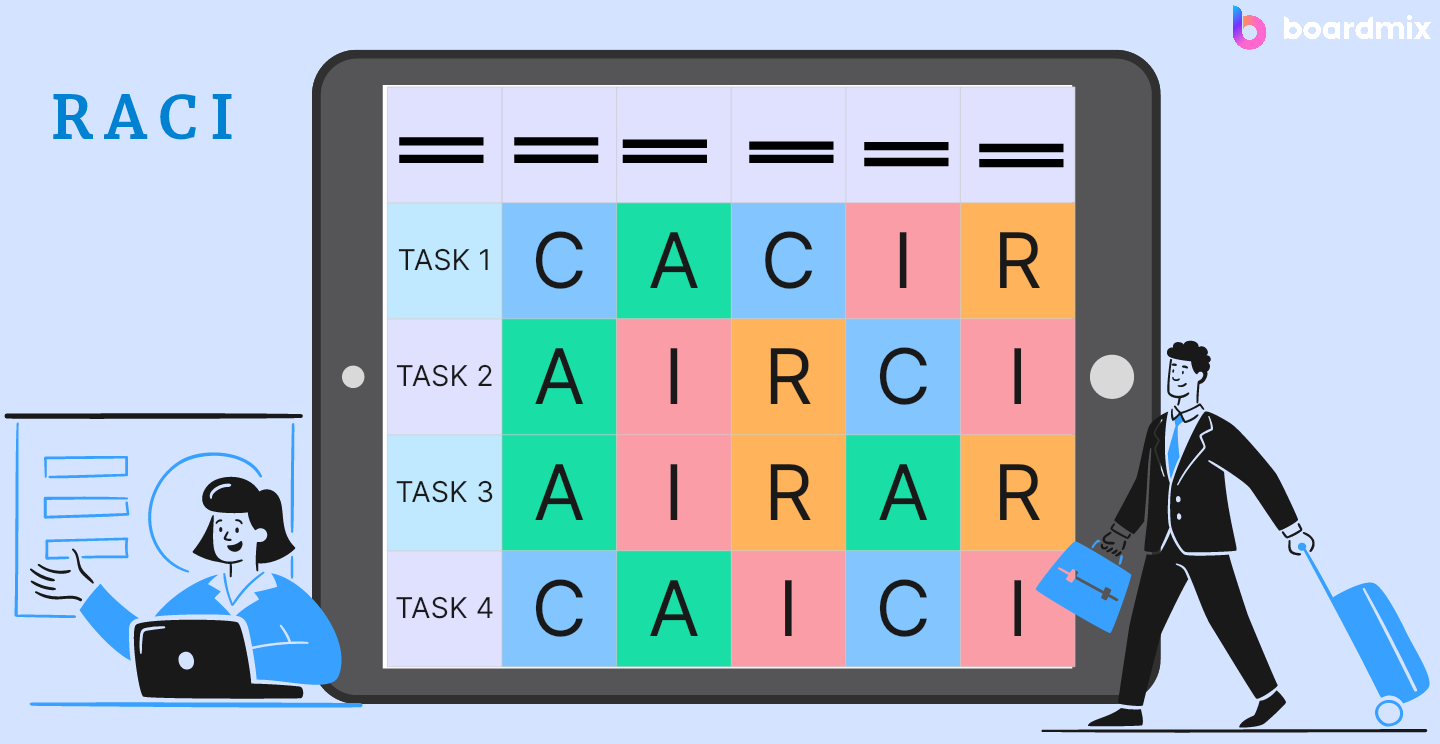
Responsible (R):
This role is assigned to individuals or groups who are responsible for performing the actual work or task.
They are the "doers" who execute the activities outlined in the project or process.
Accountable (A):
The accountable role is assigned to the person who has ultimate responsibility and authority for the success or failure of the task.
This person ensures that the work is completed satisfactorily and often oversees the efforts of those in the responsible role.
There should be only one person accountable for each task.
Consulted (C):
Individuals or groups in the consulted role provide expertise, advice, or input to the task.
While they don't perform the task themselves, their insights are valuable in ensuring a well-informed decision or outcome.
Communication is two-way between those in the consulted role and the rest of the team.
Informed (I):
Those in the informed role need to be kept in the loop about the progress or outcome of the task.
They are not directly involved in the execution or decision-making but should be aware of what is happening.
Communication is one-way, from the team or individuals carrying out the task to those who are informed.
These roles help clarify expectations, prevent confusion, and promote effective communication within a team or organization. By assigning RACI roles to each task or activity, project managers can ensure that everyone understands their responsibilities, leading to more efficient and accountable project execution.
Part 3. When to Use RACI Matrix?
The RACI matrix is a valuable project management tool that can be applied in various situations to enhance clarity, collaboration, and accountability. Here are some scenarios in which using a RACI matrix is particularly beneficial:
Complex Projects: For projects with numerous tasks, stakeholders, and dependencies, a RACI matrix helps prevent confusion by clearly defining who is responsible, accountable, consulted, and informed for each activity.
Cross-Functional Teams: In situations where team members come from different departments or disciplines, the RACI matrix helps ensure everyone understands their role, fostering better collaboration and reducing the risk of misunderstandings.
Process Improvement: When analyzing or redesigning processes, the RACI matrix aids in identifying bottlenecks, inefficiencies, or areas lacking clear ownership. It streamlines workflows by assigning roles appropriately.
Project Kickoff: Implementing a RACI matrix during the initial phases of a project sets the tone for clear communication and accountability from the start, minimizing potential issues as the project progresses.
Organizational Change: During times of organizational change or restructuring, the RACI matrix can be employed to clearly define new roles and responsibilities, ensuring a smooth transition and maintaining operational efficiency.
Risk Management: Identifying and mitigating risks is crucial in project management. The RACI matrix helps by clearly designating individuals responsible for risk-related tasks, ensuring proactive management and resolution.
Part 4. How to Use RACI Matrix?
Using a RACI matrix involves several steps to ensure effective implementation and clarity in project management. Here's a guide on how to use a RACI matrix:
Step 1: Identify Tasks and Activities
List all the tasks and activities involved in your project. Be specific and break down larger tasks into manageable components. This comprehensive task list forms the basis for your RACI matrix.
Step 2: Identify Team Members and Stakeholders
Compile a list of all team members and stakeholders involved in the project. Ensure you include everyone who has a role, whether they are internal team members, external collaborators, or stakeholders.
Step 3: Define RACI Roles
Responsible (R): Determine who will be actively performing each task. Assign one or more team members to the "Responsible" role.
Accountable (A): Designate the person who is ultimately answerable for the success or failure of the task. This role is often a single individual who ensures that the task aligns with project objectives.
Consulted (C): Identify individuals or teams whose expertise is valuable for the task. They may not execute the task but should be consulted for input.
Informed (I): Identify stakeholders or team members who need to be kept informed about the task's progress but are not directly involved in its execution.
Step 4: Fill in the Matrix
Create a matrix with tasks listed on one axis and team members/stakeholders on the other. Fill in each intersection with the appropriate RACI roles. Be sure that each task has one "Responsible" and one "Accountable" person to avoid confusion.
Step 5: Review and Adjust
Review the completed RACI matrix with the project team. Ensure that everyone understands their roles and responsibilities. Make adjustments as necessary based on feedback and changes in project dynamics.
Step 6: Communicate the RACI Matrix
Share the RACI matrix with all relevant team members and stakeholders. Ensure that everyone has access to this crucial document to refer to throughout the project.
Step 7: Monitor and Update
Regularly review and update the RACI matrix as the project progresses. Tasks and responsibilities may evolve, and adjustments may be needed to accommodate changes in team dynamics or project requirements.
Part 5. Tips for Effective RACI Matrix Implementation:
Keep it Simple: Avoid unnecessary complexity. The RACI matrix should be easy to understand and navigate.
Obtain Buy-In: Ensure that team members and stakeholders agree with their assigned roles. Discuss and resolve any concerns or questions.
Regularly Review: Periodically review the RACI matrix in team meetings to address any issues or changes promptly.
Be Flexible: Projects can evolve, and roles may need adjustment. Be flexible and update the RACI matrix as needed.
Part 6. How Boardmix Helps with RACI Chart?
Boardmix is a cutting-edge online whiteboard tool designed to revolutionize the way teams collaborate and visualize ideas. It offers a plethora of drawing templates, making it easier for users to create, share, and manage their work. One of the key features of Boardmix is its ability to facilitate RACI matrix creation. A RACI matrix is a powerful project management tool that clearly defines roles and responsibilities, ensuring everyone knows what's expected of them. With Boardmix, you can easily create a RACI matrix, assign tasks to team members, and track progress in real-time. This not only improves team communication but also boosts productivity by reducing confusion and misunderstandings.
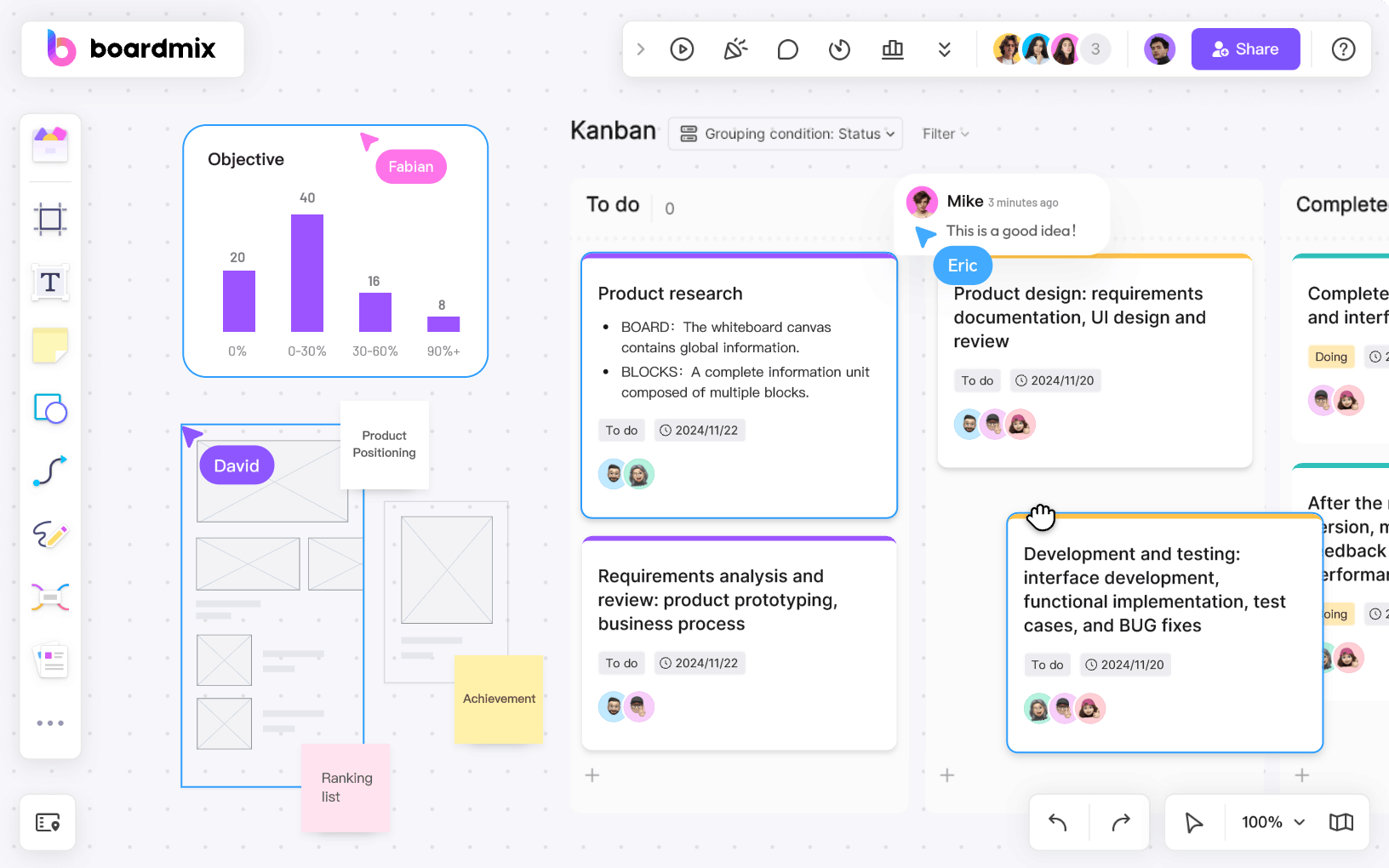
Key features of Boardmix:
- Collaborative Whiteboarding: Boardmix allows multiple users to work on the same whiteboard simultaneously, fostering real-time collaboration and idea sharing.
- Extensive Template Library: Boardmix offers a wide range of pre-designed templates, including RACI matrix, flowcharts, mind maps, and more, making it easier for users to start their projects.
- Real-Time Sharing and Feedback: With Boardmix, you can share your boards with team members instantly and receive real-time feedback, speeding up decision-making processes.
- Easy-to-Use Interface: The intuitive interface of Boardmix makes it easy for anyone to create visually appealing diagrams and charts without any design skills.
- High Customizability: Users can customize their boards with different colors, shapes, texts, and images to make their ideas stand out.
- Secure Cloud Storage: All your boards are securely stored in the cloud on Boardmix, ensuring you can access them anytime from anywhere.
How to Create a RACI Chart with Boardmix?
- Open Boardmix and select 'New Board' from the dashboard.

- Choose the 'RACI Matrix' template from our extensive library of templates.

- Once the template is loaded, start by listing your project tasks on the left-hand column and team members across the top row.
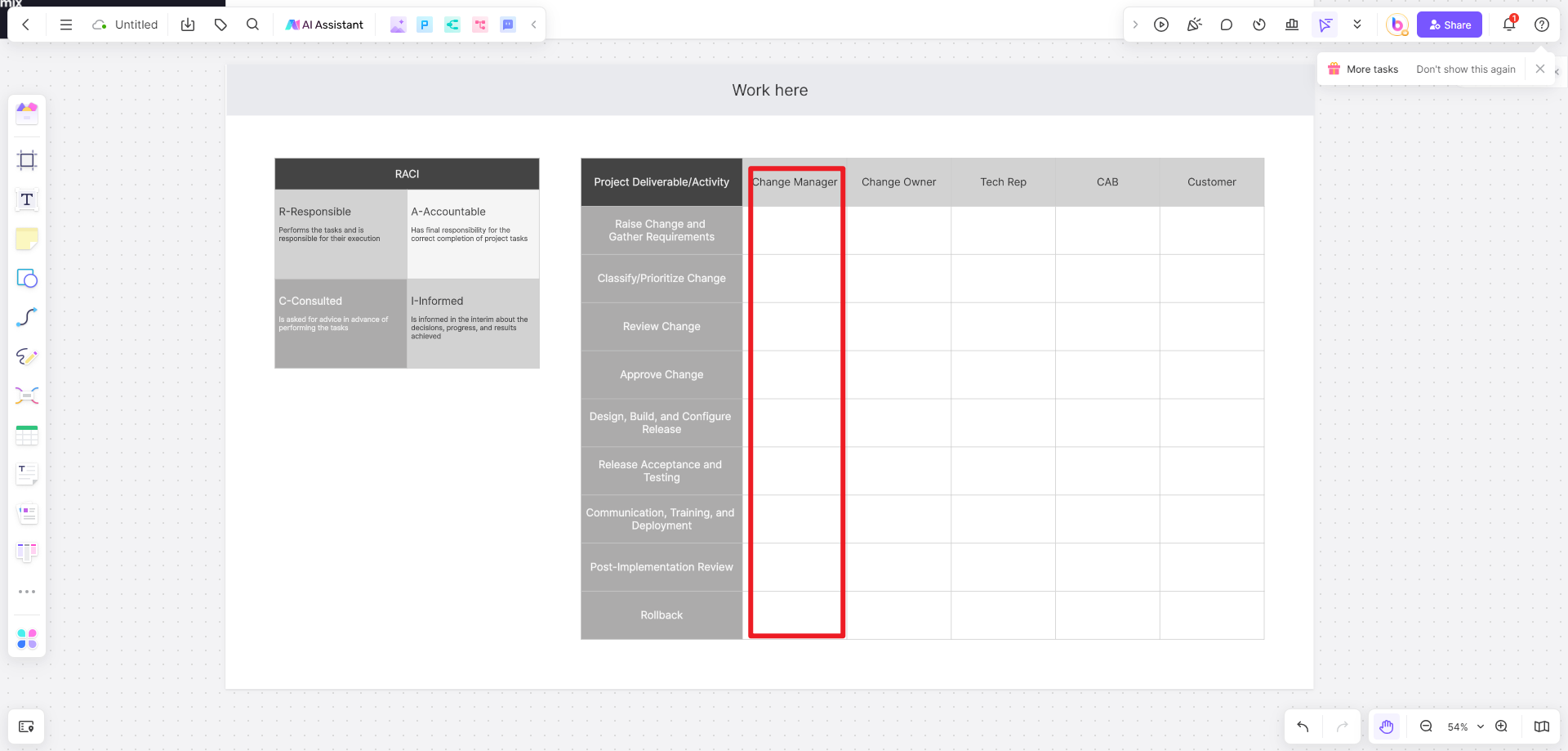
- For each task, assign roles to team members using the RACI model: Responsible, Accountable, Consulted, Informed.
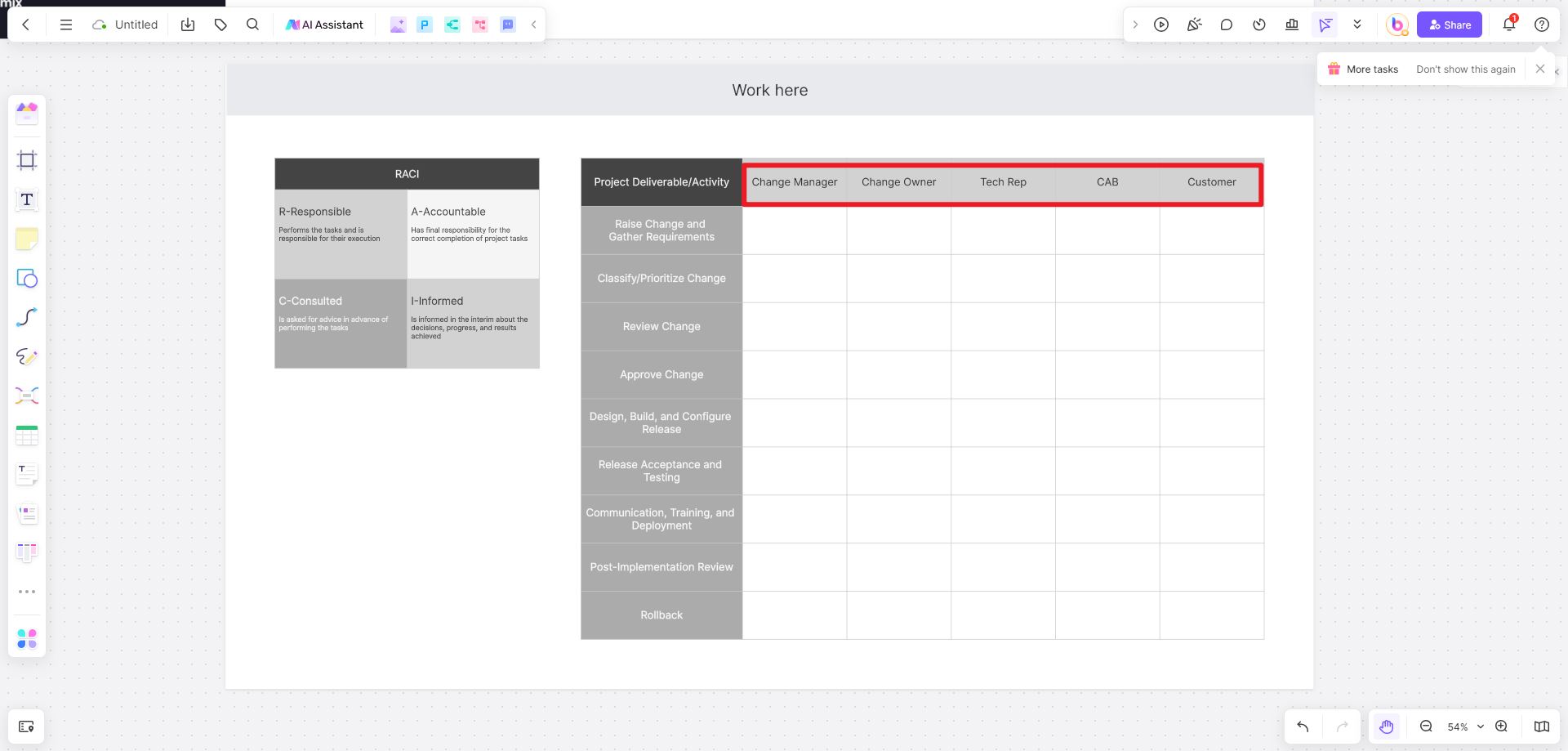
- Use different colors or symbols to represent each role for easy visualization.
- Once you've filled out your matrix, you can easily share it with your team through Boardmix's collaboration features.
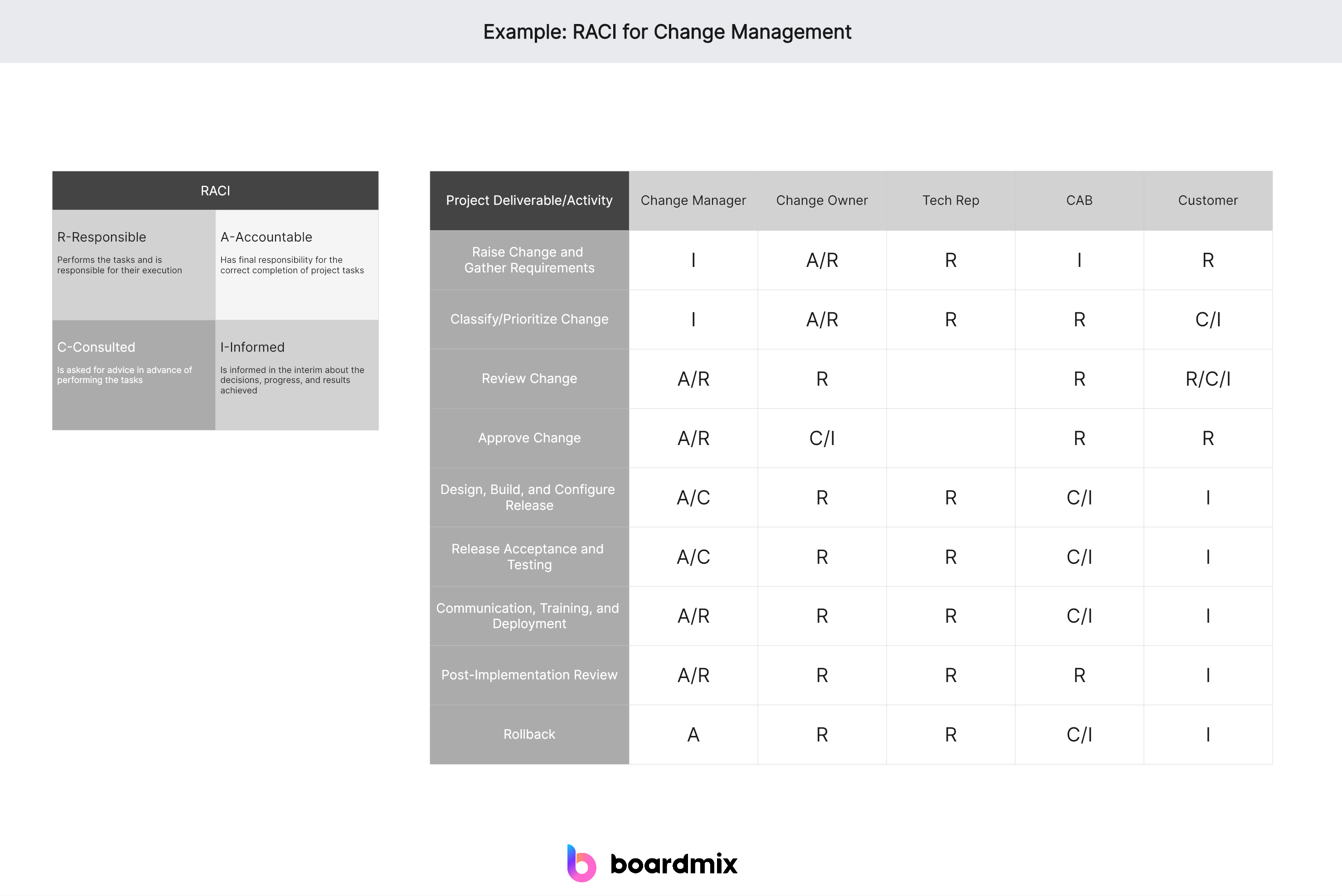
Part 7. What Are Pros and Cons of RACI Matrix?
Pros of RACI Matrix:
Clarity and Accountability: The RACI matrix provides clear and visual documentation of roles and responsibilities, reducing confusion and ensuring accountability for each task.
Enhanced Communication: Team members and stakeholders gain a better understanding of their roles, fostering improved communication and collaboration throughout the project.
Efficient Decision-Making: Designating an "Accountable" person streamlines decision-making processes, preventing delays caused by uncertainty or lack of clarity about who has the final say.
Identifies Gaps and Overlaps: The matrix helps identify any gaps in responsibilities or areas of potential overlap, allowing for adjustments to optimize workflow and prevent tasks from falling through the cracks.
Improved Project Management: Using the RACI matrix promotes more effective project management by ensuring that all aspects of a project are covered and that responsibilities align with project goals.
Enhanced Stakeholder Engagement: Stakeholders, whether internal or external, are clearly defined in their roles (Consulted or Informed), leading to better engagement and satisfaction.
Risk Management: By assigning responsibilities for risk-related tasks, the RACI matrix aids in proactive risk management, helping to prevent and address potential issues.
Cons of RACI Matrix:
Overemphasis on Roles: Overreliance on the RACI matrix can lead to a rigid view of roles, potentially stifling creativity or discouraging team members from taking initiative beyond their assigned responsibilities.
Complexity in Large Projects: In large and complex projects, the sheer volume of tasks and team members can make the RACI matrix overwhelming and challenging to maintain.
Subjectivity in Role Definition: Determining roles like "Responsible" and "Accountable" can sometimes be subjective, leading to disagreements or misunderstandings if not clearly defined from the outset.
Maintenance Overhead: Regularly updating the RACI matrix to reflect changes in project dynamics or team composition can become time-consuming and may require consistent attention to detail.
Resistance to Change: Team members accustomed to existing workflows may resist adopting the RACI matrix, especially if they perceive it as an additional administrative burden.
Limited Flexibility: The RACI matrix may struggle to adapt to rapidly changing project environments or situations where responsibilities need to shift frequently.
Dependency on Documentation: If not properly communicated or if team members do not regularly refer to the RACI matrix, its effectiveness diminishes.
In summary, while the RACI matrix offers numerous benefits for project management, it's important to be mindful of potential drawbacks and implement it thoughtfully to maximize its advantages and minimize its limitations.
FAQs about RACI Matrix
1. What is difference between responsible and accountable in RACI?
In a RACI matrix, "Responsible" signifies those actively involved in task execution, while "Accountable" designates the individual ultimately answerable for task completion and decision-making authority. Multiple individuals may be "Responsible" for a task, ensuring collaborative involvement, while only one person should be "Accountable" to maintain clear ownership and accountability. The RACI framework aids in delineating roles and responsibilities within a project or process, fostering transparency and effective collaboration.
2. Is RACI obsolete?
The RACI (Responsible, Accountable, Consulted, Informed) matrix is still widely used in project management and organizational contexts. However, the effectiveness of tools and methodologies can vary based on evolving practices and preferences within different industries.
3. What is better than RACI matrix?
The suitability of a particular framework or methodology depends on the specific needs, context, and preferences of an organization. While the RACI matrix is widely used and effective for many, some organizations may prefer or find alternatives better suited to their circumstances. Here are a few alternatives that are sometimes considered:
DACI (Driver, Approver, Contributors, Informed): Similar to RACI but distinguishes the role of the "Driver" as the person responsible for moving the task forward.
RAPID (Responsible, Accountable, Perform, Input, Decide): An alternative that includes roles like "Perform" for those carrying out the work, "Input" for providing information, and "Decide" for decision-makers.
LACE (Lead, Accountable, Consulted, Execute): Another variant that simplifies the roles to Lead, Accountable, Consulted, and Execute.
Holacracy: This is a complete organizational system that replaces traditional hierarchy with a more flexible structure based on roles and circles, aiming to distribute authority more evenly.
Agile methodologies (Scrum, Kanban): These methodologies often rely on self-organizing teams and may have different ways of defining roles and responsibilities.
Ultimately, there's no one-size-fits-all answer, and the best approach depends on the specific needs and culture of the organization. It's essential to assess and experiment with different frameworks to find the one that aligns most effectively with your team or project requirements.
4. When should you not use RACI?
Avoid using the RACI matrix for simple tasks, routine operations, or in highly dynamic environments where roles rapidly change. In small teams or urgent situations, its formality may hinder quick decision-making. Resistance to structured processes or a culture averse to formal tools can also signal the need for alternative, more adaptable approaches. Consider the specific context, organizational culture, and complexity of the task when deciding whether to use RACI or opt for simpler, more flexible tools that align better with the unique characteristics of your team or project.
Conclusion
The RACI matrix is a valuable tool for project managers seeking to enhance collaboration, communication, and accountability within their teams. By clearly defining roles and responsibilities, this framework contributes to the overall success of projects, ensuring that tasks are completed efficiently and with a shared understanding of expectations. Incorporating the RACI matrix into project management practices can lead to more streamlined processes, improved teamwork, and ultimately, greater project success.
Boardmix is the ultimate tool for creating RACI matrices, offering an intuitive interface and a wide range of pre-designed templates that make the process effortless. Its real-time collaboration feature allows team members to work together seamlessly, ensuring clear communication and efficient task allocation. With Boardmix, you can easily visualize roles and responsibilities, streamline your project management, and boost your team's productivity.








